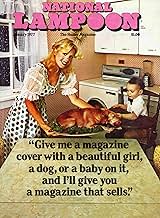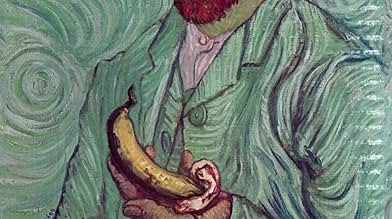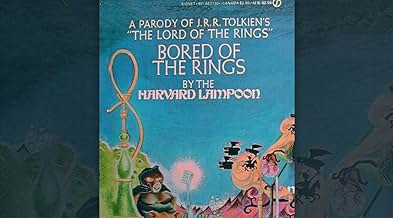Ajouter une intrigue dans votre langueA look at the history of the American comedy publication and production company, National Lampoon, from its beginning in the 1970s to 2010, featuring rare and never-before-seen footage.A look at the history of the American comedy publication and production company, National Lampoon, from its beginning in the 1970s to 2010, featuring rare and never-before-seen footage.A look at the history of the American comedy publication and production company, National Lampoon, from its beginning in the 1970s to 2010, featuring rare and never-before-seen footage.
- Prix
- 5 nominations au total
- Self
- (archive footage)
- …
- Self - Lampoon Staff
- (as Judith Jacklin Belushi)
- Self
- (archive footage)
- …
- Self - Lampoon Contributor
- (as Chris Cerf)
- Self
- (archive footage)
- …
Avis en vedette
As the documentary pointed out, the magazine grew from the Harvard Lampoon, a Harvard humour magazine that didn't reach a national audience. In the 1920s there were nationally published magazines that collected articles and cartoons from universities around the US: "College Humor" was probably the largest, and was published from 1920 to the 1940s. These college humor magazines were aimed at a young but mainstream audience.
It surprised me that Drunk Stone Brilliant Dead didn't mention Mad magazine. It was Mad. first published in 1952, that brought radical and subversive humour that poked fun at authority figures to a country wide audience. Without Mad, there probably wouldn't have been a National Lampoon. It also surprised me that the documentary made no mention of the Underground press and Underground comics of the 1960s. The art style of the first issues of the Lampoon looked very reminiscent of the style of Robert Crumb and other artists from Zap.
I didn't like National Lampoon very much in the 1970s. I read my older brother's issues. Even back then, I thought they were indulging in printing pictures of naked girls and making jokes about drugs and sex simply for the sake of it. They didn't have the force of the Underground comics, which were breaking ground in discussing subjects that before then couldn't be mentioned, and were using the archaic spirit of Mad to take apart the establishment and cultural heritage of the era. I remember the issue of National Lampoon that printed a spoof of Mad, taunting that Mad was stuffy, middle aged, and had long forgotten the meaning of satire. I thought that while Mad didn't print cartoons of naked women and guys smoking pot and snorting coke, it still featured strips that aptly commented on society: strips that have been reprinted and discussed in many studies about US history and the growth of graphic novels.
I thought while I was watching the documentary that National Lampoon branched out very quickly into other media and became a brand: while Saturday Night Live wasn't officially associated with National Lampoon the show clearly stole their talent and their style of satire. I think the magazine pulled its punches keeping an eye on their advertising revenue and growing empire. I'm not saying it wasn't funny- I thought the record albums and movies were funny- but I think the humour of the magazine was aimed at pleasing its creators and audience of liked minded readers, rather than exposing the darker aspects of its targets. The publisher of Mad, William M Gaines, didn't allow advertising in the magazine because he said a satire magazine couldn't make fun of an advertising campaign and then print an ad a few pages later for the same product or a similar product. He also saw it as a practical issue, saying that the magazine would then try to attract more advertisers, and if it started losing some of its advertisers and the advertising income, the readers would still expect the same fancy package, but without the advertising income to pay for the higher production costs, the magazine was sunk. Which it seems, along with loss of readership, was what ultimately happened to National Lampoon.
For those under about age 50 the National Lampoon is remembered for the movies that began in 1978 with the classic "Animal House" and then the series of "Vacation" movies, plus some others over the years not worth mentioning. The success of AH would continue the siphoning of the NL's most talented writers and performers (the NL Radio Show, which ran on Saturday evenings on a syndicated network, mostly AOR stations. Included Belushi, C Chase, Radner, Ramis and the Murray Bros.) which had begun with NBC's SNL. The NL couldn't compete with the money, fame and women that movies and TV offered their creative talent and the magazine died a slow death in the 80's. "DSBD" is a great look at this quick rise and fall of a comedy empire.
*** 1/2 (out of 4)
If you're a fan of the National Lampoon's magazine then you're certainly going to want to check this documentary out. The rise and fall of the magazine is discussed in this highly entertaining documentary that features interviews with surviving members of the magazine as well as those who got their start in the movies like NATIONAL LAMPOON'S ANIMAL HOUSE, CADDYSHACK and NATIONAL LAMPOON'S VACATION.
There's some really good material to have here but the documentary works the best for those who are unfamiliar with the magazine or just don't know the complete history behind it. We get some great stories about the early days as well as how the magazine finally took off, which of course led to Hollywood calling. There's some discussion of Saturday Night Live who stole a lot of their talent as well as some of the darker stories including the death of one of the founding members.
There are some great stories throughout this and there are some great interviews as well. I must say that the interview with Chevy Chase was probably my favorite because we really see a different side of him including a rather painful side as he talks about losing his best friend.
Yet from watching this documentary I learned a lot about National Lampoon's and that was it got it's start from educated college guys and in fact it use to be a "Harvard" university magazine! Along the way after it branched out to a magazine it expanded to the radio airwaves, then even began Lampoon plays and stand up routines. Many of the stories written in the magazine would later become hit movies most notable was 1983's "Vacation" and the Lampoon industry would launch the creation of "NBC's" "Saturday Night Live".
And this documentary provided many good interviews from stars who got their start from the Lampoon franchise like Chevy Chase and Kevin Bacon and even John Goodman. And this picture told of the company history showing great highlights and drawings and covers of the magazine and news clips and commentary on how National Lampoon really did cause a stir with American society. Really this was a well done and good documentary to watch.
Le saviez-vous
- AnecdotesComedians John Belushi, Chevy Chase, Gilda Radner, Bill Murray, Brian Doyle-Murray first gained attention as part of National Lampoon's stage and radio shows before gaining fame on Saturday Night Live. Michael O'Donoghue was a founder, writer, and editor for the National Lampoon magazine before becoming the first head writer of Saturday Night Live.
- Citations
Henry Beard, Himself: It was like we had an attic full of culture that had been accumulating from 1945 to 1970. And we opened the trap door and nobody had been up there. And we just basically looted it!
- Bandes originalesThe Jean Genie
Written by David Bowie
Performed by David Bowie
Published by Tintoretto Music (BMI) administered by RZO Music, Inc., EMI Blackwood Music Inc. o/b/o EMI Music Publishing Ltd. (administered by Sony/ATV Music Publishing LLC.) and BMG Blue on behalf of Chrysalis Music Ltd.
Courtesy of RZO Music
Meilleurs choix
- How long is Drunk Stoned Brilliant Dead?Propulsé par Alexa
Détails
- Date de sortie
- Pays d’origine
- Sites officiels
- Langue
- Aussi connu sous le nom de
- Drunk Stoned Brilliant Dead
- sociétés de production
- Consultez plus de crédits d'entreprise sur IMDbPro
Box-office
- Brut – États-Unis et Canada
- 62 660 $ US
- Fin de semaine d'ouverture – États-Unis et Canada
- 5 254 $ US
- 27 sept. 2015
- Brut – à l'échelle mondiale
- 62 660 $ US
- Durée1 heure 38 minutes
- Couleur

































